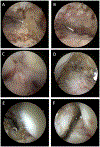Arthrofibrosis Nightmares: Prevention and Management Strategies
- PMID: 35113841
- PMCID: PMC8830598
- DOI: 10.1097/JSA.0000000000000324
Arthrofibrosis Nightmares: Prevention and Management Strategies
Abstract
Arthrofibrosis (AF) is an exaggerated immune response to a proinflammatory insult leading to pathologic periarticular fibrosis and symptomatic joint stiffness. The knee, elbow, and shoulder are particularly susceptible to AF, often in the setting of trauma, surgery, or adhesive capsulitis. Prevention through early physiotherapeutic interventions and anti-inflammatory medications remain fundamental to avoiding motion loss. Reliable nonoperative modalities exist and outcomes are improved when etiology, joint involved, and level of dysfunction are considered in the clinical decision making process. Surgical procedures should be reserved for cases recalcitrant to nonoperative measures. The purpose of this review is to provide an overview of the current understanding of AF pathophysiology, identify common risk factors, describe prevention strategies, and outline both nonoperative and surgical treatment options. This manuscript will focus specifically on sterile AF of the knee, elbow, and shoulder.
Copyright © 2022 Wolters Kluwer Health, Inc. All rights reserved.
Conflict of interest statement
Disclosure: C.L.C. reports personal fees and nonfinancial support from Arthrex, nonfinancial support from Zimmer Biomet, nonfinancial support from Stryker Corporation. A.J.K. reports grants from Aesculap/B.Braun, other from American Journal of Sports Medicine, personal fees and other from Arthrex Inc., grants from Arthritis foundation, grants from Ceterix, grants from Histogenics, other from International Cartilage Repair Society, other from International society of Arthroscopy, Knee surgery, and orthopaedic sports medicine, other from Minnesota Orthopedic society, personal fees and other from Musculoskeletal Transplant Foundation, personal fees from Vericel, personal fees from DePuy, personal fees from JRF, grants from Exactech, grants from Gemini Medical, personal fees from Responsive Arthroscopy. M.J.S. reports involvement in the editorial or governing board for the American Journal of Sports Medicine, grants and personal fees from Arthrex Inc., grants from Stryker. M.P.A. reports involvement in the board or committee member of AAOS, publishing royalties, financial or material support from Springer, and IP royalties from Stryker. B.A.L. reports personal fees from Arthrex Inc.: IP royalties; Paid consultant, grants from Biomet: Research support, editorial or governing board for Clinical Orthopaedics and Related Research, Journal of Knee Surgery, Knee Surgery, Sports Traumatology, Arthroscopy, Orthopedics Today; grants and personal fees from Smith & Nephew: Paid consultant; Research support, grants from Stryker: Research support, personal fees from Linvatec: Faculty/speaker, personal fees from COVR Medical LLC. The remaining authors declare no conflict of interest.
Figures







References
-
- Ibrahim IO, Nazarian A, Rodriguez EK. Clinical Management of Arthrofibrosis: State of the Art and Therapeutic Outlook. JBJS Rev. 2020;8(7):e1900223. - PubMed
-
- Chen AF, Lee YS, Seidl AJ, et al. Arthrofibrosis and large joint scarring. Connect Tissue Res. 2019;60(1):21–28. - PubMed
-
- Abdel MP, Morrey ME, Barlow JD, et al. Myofibroblast cells are preferentially expressed early in a rabbit model of joint contracture. J Orthop Res. 2012;30(5):713–719. - PubMed
-
- Magit D, Wolff A, Sutton K, et al. Arthrofibrosis of the knee. J Am Acad Orthop Surg. 2007;15(11):682–694. - PubMed
Publication types
MeSH terms
Grants and funding
LinkOut - more resources
Full Text Sources
Medical

